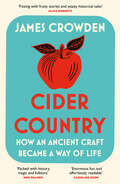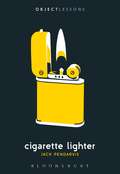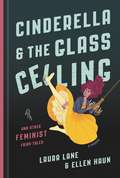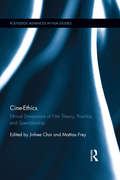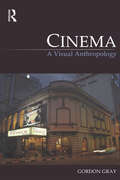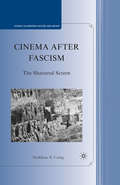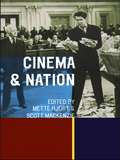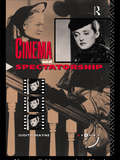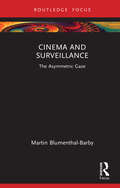- Table View
- List View
Cicero, Classicism, and Popular Culture
by Marshall FishwickLearn why Cicero is considered one of the most important individuals in all of Western culture!Marcus Tullius Cicero (106-43 BC) was a poet, philosopher, writer, scholar, barrister, statesman, patriot, and the linguist who helped make Latin into a universal language. His many influences in rhetoric, politics, literature, and ideas are seen throughout Western civilization. Cicero, Classicism, and Popular Culture explores the fascinating man behind the eloquence and his monumental effect on language, morality, and popularity of Western culture. One of the leading authorities on popular culture, Dr. Marshall Fishwick discusses the multifaceted man who may be, besides Jesus, the central figure in all of Western civilization.The author recounts his own personal quest of traveling the land and ancient cities of Italy, gleaning insights from people he met along the way who have knowledge about Cicero&’s life and times. However, Cicero, Classicism, and Popular Culture is more than a simple search for the man and his accomplishments, a man whose mere words changed the way people think. This book shows in each of us the roots of our own ideas, beliefs, and culture. Cicero, Classicism, and Popular Culture discusses: Cicero&’s rise to acclaim his affect on the language of popular culture common traits Cicero shared with Thomas Jefferson rhetoric, the art of oratory community two pivotal essays on friendship and old age vision of his reputation the search for peace Marshall McLuhan, Ciceronian Cicero&’s Rome Cicero&’s ancestral home of Arpinum Julius Caesar, politics, and the influences of Cicero the Roman republic and its downfall America as the new Rome much more!Cicero, Classicism, and Popular Culture is a startling, entertaining examination of the man who made Western culture what it is today. The book is insightful reading for educators, students, or anyone interested in one of the major forces in popular culture.
Cicero, Philippic 2, 44–50, 78–92, 100–119 Latin text, study aids with vocabulary, and commentary (PDF)
by Ingo GildenhardCicero composed his incendiary Philippics only a few months after Rome was rocked by the brutal assassination of Julius Caesar. In the tumultuous aftermath of Caesar’s death, Cicero and Mark Antony found themselves on opposing sides of an increasingly bitter and dangerous battle for control. Philippic 2 was a weapon in that war. Conceived as Cicero’s response to a verbal attack from Antony in the Senate, Philippic 2 is a rhetorical firework that ranges from abusive references to Antony’s supposedly sordid sex life to a sustained critique of what Cicero saw as Antony’s tyrannical ambitions. Vituperatively brilliant and politically committed, it is both a carefully crafted literary artefact and an explosive example of crisis rhetoric. It ultimately led to Cicero’s own gruesome death. This course book offers a portion of the original Latin text, vocabulary aids, study questions, and an extensive commentary. Designed to stretch and stimulate readers, Ingo Gildenhard’s volume will be of particular interest to students of Latin studying for A-Level or on undergraduate courses. It extends beyond detailed linguistic analysis to encourage critical engagement with Cicero, his oratory, the politics of late-republican Rome, and the transhistorical import of Cicero’s politics of verbal (and physical) violence.
Cider Country: How An Ancient Craft Became A Way Of Life
by James Crowden‘James Crowden is Britain’s best cider writer … Cider Country is the book we’ve all been waiting for.’ Oz Clarke Join James Crowden as he embarks on a journey to distil the ancient origins of cider, uncovering a rich culture and philosophy that has united farmer, maker and drinker for millennia.
Cigarette Lighter (Object Lessons)
by Jack PendarvisObject Lessons is a series of short, beautifully designed books about the hidden lives of ordinary things. Smokers, survivalists, teenagers, collectors…. The cigarette lighter is a charged, complex, yet often entirely disposable object that moves across these various groups of people, acquiring and emitting different meanings while always supplying its primary function, that of ignition. While the lighter may seem at first a niche object-only for old fashioned cigarette smokers-in this book Jack Pendarvis explodes the lighter as something with deep history, as something with quirky episodes in cultural contexts, and as something that dances with wide ranging taboos and traditions. Pendarvis shows how the lighter tarries with the cheapest ends of consumer culture as much as it displays more profound dramas of human survival, technological advances, and aesthetics.Object Lessons is published in partnership with an essay series in the The Atlantic.
Cigarette Lighter (Object Lessons)
by Jack PendarvisObject Lessons is a series of short, beautifully designed books about the hidden lives of ordinary things. Smokers, survivalists, teenagers, collectors…. The cigarette lighter is a charged, complex, yet often entirely disposable object that moves across these various groups of people, acquiring and emitting different meanings while always supplying its primary function, that of ignition. While the lighter may seem at first a niche object-only for old fashioned cigarette smokers-in this book Jack Pendarvis explodes the lighter as something with deep history, as something with quirky episodes in cultural contexts, and as something that dances with wide ranging taboos and traditions. Pendarvis shows how the lighter tarries with the cheapest ends of consumer culture as much as it displays more profound dramas of human survival, technological advances, and aesthetics.Object Lessons is published in partnership with an essay series in the The Atlantic.
Cinderella and the Glass Ceiling: And Other Feminist Fairy Tales
by Laura Lane Ellen Haunp.p1 {margin: 0.0px 0.0px 0.0px 0.0px; font: 13.3px Times} This wickedly wise (and wisecracking) parody of classic fairy tales redefines happily ever after for the modern feminist era.You know what? It's super creepy to kiss a woman who is unconscious. And you know what else? The way out of poverty isn't by marrying a rich dude -- or by wearing fragile footwear, for that matter. And while we're at it, why is the only woman who lives with seven men expected to do the cooking, cleaning, and laundry?Fairytales need a reboot, and comedy queens Laura Lane and Ellen Haun are the women to do it. In Cinderella and the Glass Ceiling, they offer a rollicking parody of classic (read: patriarchal) tales that turns sweet, submissive princesses into women who are perfectly capable of being the heroes of their own stories. Mulan climbs the ranks in the army but wages a different war when she finds out she's getting paid less than her fellow male captains, Wendy learns never to trust a man-boy stalking her window, Sleeping Beauty's prince gets a lesson in consent, and more.Busting with laugh-out-loud, razor-sharp twists to these outdated tales, Cinderella and the Glass Ceiling is fun, magical, necessary, and totally woke.
Cine-Ethics: Ethical Dimensions of Film Theory, Practice, and Spectatorship (Routledge Advances in Film Studies)
by Jinhee Choi Mattias FreyThis volume looks at the significance and range of ethical questions that pertain to various film practices. Diverse philosophical traditions provide useful frameworks to discuss spectators’ affective and emotional engagement with film, which can function as a moral ground for one’s connection to others and to the world outside the self. These traditions encompass theories of emotion, phenomenology, the philosophy of compassion, and analytic and continental ethical thinking and environmental ethics. This anthology is one of the first volumes to open up a dialogue among these diverse methodologies. Contributors bring to the fore some of the assumptions implicitly shared between these theories and forge a new relationship between them in order to explore the moral engagement of the spectator and the ethical consequences of both producing and consuming films
Cine-Ethics: Ethical Dimensions of Film Theory, Practice, and Spectatorship (Routledge Advances in Film Studies)
by Jinhee Choi Mattias FreyThis volume looks at the significance and range of ethical questions that pertain to various film practices. Diverse philosophical traditions provide useful frameworks to discuss spectators’ affective and emotional engagement with film, which can function as a moral ground for one’s connection to others and to the world outside the self. These traditions encompass theories of emotion, phenomenology, the philosophy of compassion, and analytic and continental ethical thinking and environmental ethics. This anthology is one of the first volumes to open up a dialogue among these diverse methodologies. Contributors bring to the fore some of the assumptions implicitly shared between these theories and forge a new relationship between them in order to explore the moral engagement of the spectator and the ethical consequences of both producing and consuming films
Cinema
by Alain BadiouFor Alain Badiou, films think, and it is the task of the philosopher to transcribe that thinking. What is the subject to which the film gives expressive form? This is the question that lies at the heart of Badiou’s account of cinema. He contends that cinema is an art form that bears witness to the Other and renders human presence visible, thus testifying to the universal value of human existence and human freedom. Through the experience of viewing, the movement of thought that constitutes the film is passed on to the viewer, who thereby encounters an aspect of the world and its exaltation and vitality as well as its difficulty and complexity. Cinema is an impure art cannibalizing its times, the other arts, and people – a major art precisely because it is the locus of the indiscernibility between art and non-art. It is this, argues Badiou, that makes cinema the social and political art par excellence, the best indicator of our civilization, in the way that Greek tragedy, the coming-of-age novel and the operetta were in their respective eras.
Cinema
by Alain BadiouFor Alain Badiou, films think, and it is the task of the philosopher to transcribe that thinking. What is the subject to which the film gives expressive form? This is the question that lies at the heart of Badiou’s account of cinema. He contends that cinema is an art form that bears witness to the Other and renders human presence visible, thus testifying to the universal value of human existence and human freedom. Through the experience of viewing, the movement of thought that constitutes the film is passed on to the viewer, who thereby encounters an aspect of the world and its exaltation and vitality as well as its difficulty and complexity. Cinema is an impure art cannibalizing its times, the other arts, and people – a major art precisely because it is the locus of the indiscernibility between art and non-art. It is this, argues Badiou, that makes cinema the social and political art par excellence, the best indicator of our civilization, in the way that Greek tragedy, the coming-of-age novel and the operetta were in their respective eras.
Cinema: A Visual Anthropology (Key Texts in the Anthropology of Visual and Material Culture)
by Gordon GrayCinema: A Visual Anthropology provides a clear and concise summary of the key ideas, debates, and texts of the most important approaches to the study of fiction film from around the world. The book examines ways to address film and film experience beyond the study of the audience. Cross-disciplinary in scope, Cinema uses ideas and approaches both from within and outside of anthropology to further students' knowledge of and interest in fiction film. Including selected, globally based case studies to highlight and exemplify important issues, the book also contains suggested Further Reading for each chapter, for students to expand their learning independently. Exploring fundamental methods and approaches to engage this most interesting and vibrant of media, Cinema will be essential reading for students of anthropology and film.
Cinema: A Visual Anthropology (Key Texts In The Anthropology Of Visual And Material Culture Ser. #1)
by Gordon GrayCinema: A Visual Anthropology provides a clear and concise summary of the key ideas, debates, and texts of the most important approaches to the study of fiction film from around the world. The book examines ways to address film and film experience beyond the study of the audience. Cross-disciplinary in scope, Cinema uses ideas and approaches both from within and outside of anthropology to further students' knowledge of and interest in fiction film. Including selected, globally based case studies to highlight and exemplify important issues, the book also contains suggested Further Reading for each chapter, for students to expand their learning independently. Exploring fundamental methods and approaches to engage this most interesting and vibrant of media, Cinema will be essential reading for students of anthropology and film.
Cinema: A Visual Anthropology
by Gordon GrayCinema: A Visual Anthropology provides a clear and concise summary of the key ideas, debates, and texts of the most important approaches to the study of fiction film from around the world. The book examines ways to address film and film experience beyond the study of the audience. Cross-disciplinary in scope, Cinema uses ideas and approaches both from within and outside of anthropology to further students' knowledge of and interest in fiction film. Including selected, globally based case studies to highlight and exemplify important issues, the book also contains suggested Further Reading for each chapter, for students to expand their learning independently. Exploring fundamental methods and approaches to engage this most interesting and vibrant of media, Cinema will be essential reading for students of anthropology and film.
Cinema after Fascism: The Shattered Screen (Studies in European Culture and History)
by S. CraigCinema After Fascism considers how postwar European films glance ambivalently backward from the postwar period to the fascist era and delves into issues of gender certainties and spectatorship. In this period of film, familiar structures of epistemology and historiography reappear as ghostly imprints on postwar celluloid, and the remnants of fascist subjectivity walk the streets of postwar cities. Through new perspectives on the films of Roberto Rossellini, Billy Wilder, Carol Reed, Alain Resnais, and Marguerite Duras, this book examines the ways in which filmmakers acknowledge the fascist past. Siobhan S. Craig reveals that the attempts to reconfigure the idioms of cinema are never fully naturalized and remain highly precarious constructions.
Cinema Against Doublethink: Ethical Encounters with the Lost Pasts of World History (Remapping World Cinema)
by David Martin-JonesWhen is it OK to lie about the past? If history is a story, then everyone knows that the 'official story' is told by the winners. No matter what we may know about how the past really happened, history is as it is recorded: this is what George Orwell called doublethink. But what happens to all the lost, forgotten, censored, and disappeared pasts of world history? Cinema Against Doublethink uncovers how a world of cinemas acts as a giant archive of these lost pasts, a vast virtual store of the world’s memories. The most enchanting and disturbing films of recent years – Uncle Boonmee Who Can Recall his Past Lives, Nostalgia for the Light, Even the Rain, The Act of Killing, Carancho, Lady Vengeance – create ethical encounters with these lost pasts, covering vast swathes of the planet and crossing huge eras of time. Analysed using the philosophies of Gilles Deleuze (the time-image) and Enrique Dussel (transmodern ethics), the multitudinous cinemas of the world are shown to speak out against doublethink, countering this biggest lie of all with their myriad 'false' versions of world history. Cinema, acting against doublethink, remains a powerful agent for reclaiming the truth of history for the 'post-truth' era.
Cinema and Community
by D. McKiernanIn the first book-length study of this topic, D.W. McKiernan examines the way mainstream commercial cinema represents society's complex relationship with the idea and practice of community in the context of rapidly changing social conditions. Films examined include Ae Fond Kiss, The Idiots and Monsoon Wedding.
Cinema and Nation
by Mette Hjort Scott MackenzieIdeas of national identity, nationalism and transnationalism are now a central feature of contemporary film studies, as well as primary concerns for film-makers themselves. Embracing a range of national cinemas including Scotland, Poland, France, Turkey, Indonesia, India, Germany and America, Cinema and Nation considers the ways in which film production and reception are shaped by ideas of national belonging and examines the implications of globalisation for the concept of national cinema.In the first three Parts, contributors explore sociological approaches to nationalism, challenge the established definitions of 'national cinema', and consider the ways in which states - from the old Soviet Union to contemporary Scotland - aim to create a national culture through cinema. The final two Parts address the diverse strategies involved in the production of national cinema and consider how images of the nation are used and understood by audiences both at home and abroad.
Cinema and Nation
by Mette Hjort Scott MacKenzieIdeas of national identity, nationalism and transnationalism are now a central feature of contemporary film studies, as well as primary concerns for film-makers themselves. Embracing a range of national cinemas including Scotland, Poland, France, Turkey, Indonesia, India, Germany and America, Cinema and Nation considers the ways in which film production and reception are shaped by ideas of national belonging and examines the implications of globalisation for the concept of national cinema.In the first three Parts, contributors explore sociological approaches to nationalism, challenge the established definitions of 'national cinema', and consider the ways in which states - from the old Soviet Union to contemporary Scotland - aim to create a national culture through cinema. The final two Parts address the diverse strategies involved in the production of national cinema and consider how images of the nation are used and understood by audiences both at home and abroad.
Cinema and Society in the British Empire, 1895-1940 (Britain and the World)
by James BurnsBy 1940 going to the movies was the most popular form of public leisure in Britain's empire. This book explores the social and cultural impact of the movies in colonial societies in the early cinema age.
Cinema and Spectatorship
by Judith MayneCinema and Spectatorship is the first book to focus entirely on the history and role of the spectator in contemporary film studies. While 1970s film theory insisted on a distinction betweeen the cinematic subject and film-goers, Judith Mayne suggests that a very real friction between "subjects" and "viewers" is in fact central to the study of spectatorship.In the book's first section Mayne examines three theoretical models of spectatorship: the perceptual, the institutional and the historical, while the second section focuses on case studies which crystallize many of the issues already discussed, concentrating on textual analysis, the `disrupting genre', `star-gazing' and finally the audience itself. Case studies incude the place of the spectator in the textual analysis of individual films such as The Picture of Dorian Gray; the construction of Bette Davis' star persona; fantasies of race and film viewing in Field of Dreams and Ghost; and gay and lesbian audiences as "critical" audiences. The book provides a very thorough and accessible overview of this complex, fragmented and often controversial area of film theory.
Cinema and Spectatorship
by Judith MayneCinema and Spectatorship is the first book to focus entirely on the history and role of the spectator in contemporary film studies. While 1970s film theory insisted on a distinction betweeen the cinematic subject and film-goers, Judith Mayne suggests that a very real friction between "subjects" and "viewers" is in fact central to the study of spectatorship.In the book's first section Mayne examines three theoretical models of spectatorship: the perceptual, the institutional and the historical, while the second section focuses on case studies which crystallize many of the issues already discussed, concentrating on textual analysis, the `disrupting genre', `star-gazing' and finally the audience itself. Case studies incude the place of the spectator in the textual analysis of individual films such as The Picture of Dorian Gray; the construction of Bette Davis' star persona; fantasies of race and film viewing in Field of Dreams and Ghost; and gay and lesbian audiences as "critical" audiences. The book provides a very thorough and accessible overview of this complex, fragmented and often controversial area of film theory.
Cinema and Surveillance: The Asymmetric Gaze (Routledge Focus on Film Studies)
by Martin Blumenthal-BarbyCinema and Surveillance: The Asymmetric Gaze shows how key modern filmmakers challenge and disturb the relation between film and surveillance, medium and message. Assembling readings of films by Harun Farocki, Michael Haneke, and Fritz Lang, the book considers surveillance in such different domains as urban life, religious doctrine, and law enforcement. With surveillance present in the modern world as both a technological phenomenon and a social practice, the author shows how cinema, as a visual medium, presents highly sophisticated analyses of surveillance. He suggests that “surveillance” is less an issue to be tackled from a secure spectatorial position than an experience to be rendered, an event to be dealt with. Far from offering a general model of spectatorship, the book explores how narrative moments of surveillance are complicated by specific spectatorial responses.In its intersection of well-known figures and a highly topical issue, this book will have broad appeal, especially, but not exclusively, among students and scholars in film studies, media studies, German studies, European studies, art history, and political theory.
Cinema and Surveillance: The Asymmetric Gaze (Routledge Focus on Film Studies)
by Martin Blumenthal-BarbyCinema and Surveillance: The Asymmetric Gaze shows how key modern filmmakers challenge and disturb the relation between film and surveillance, medium and message. Assembling readings of films by Harun Farocki, Michael Haneke, and Fritz Lang, the book considers surveillance in such different domains as urban life, religious doctrine, and law enforcement. With surveillance present in the modern world as both a technological phenomenon and a social practice, the author shows how cinema, as a visual medium, presents highly sophisticated analyses of surveillance. He suggests that “surveillance” is less an issue to be tackled from a secure spectatorial position than an experience to be rendered, an event to be dealt with. Far from offering a general model of spectatorship, the book explores how narrative moments of surveillance are complicated by specific spectatorial responses.In its intersection of well-known figures and a highly topical issue, this book will have broad appeal, especially, but not exclusively, among students and scholars in film studies, media studies, German studies, European studies, art history, and political theory.
Cinema and the Algerian War of Independence: Culture, Politics, and Society (Palgrave Studies in Arab Cinema)
by Ahmed BedjaouiThe book examines the war of images between France and Algeria. Discussing the role of the United States during the war, it covers topics such the presence of American reporters in Algeria, John F. Kennedy’s support for Algerian independence while a senator, the broadcasting of documentaries on the Algerian war on public television, and reporting in the press. Even half a century after Algerian independence, there remains a need for both film and literature on the war from both sides of the Mediterranean. This might seem surprising, particularly to media professionals, given the quantity of output on the subject, but both French and Algerian portrayals of the war remain flawed and shackled to their respective ideologies.The generation of FLN leaders recognized early on the importance of images, and established a clandestine film structure that would bring the Algerian cause to the world stage.The book offers an insightful and timely contribution not just to the field of North African studies but also to other disciplines, such as film and media studies, anthropology, history, journalism, and political science. Providing a rich source of research topics and viable ideas for film and documentary projects, it is a must-read for students, scholars and media professionals alike.
Cinema and the Swastika: The International Expansion of Third Reich Cinema
by Roel Vande Winkel and David WelchThis is the first publication to bring together comparative research on the international expansion of Third Reich cinema. This volume investigates various attempts to infiltrate - economically, politically and culturally - the film industries of 20 countries and regions either occupied by, friendly with or neutral towards Nazi Germany.


